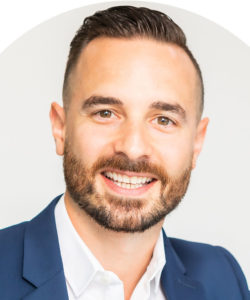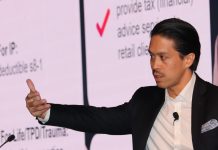If you want to enhance your advice business model you need to invest in external input, because how can you run a better advice practice if you’re not getting advice yourself?
That was a key takeaway from Melbourne-based adviser, Aaron Kane’s address at MDRT’s three-day 2021 virtual Annual Meeting, as he explained how his business increased client fee revenue by 45 percent during the pandemic, while delivering advice to fewer clients…
Kane says it all comes down to a simple equation in which fewer clients – but the right clients who want to pay for advice – generate more revenue for the business.
He told the thousands of adviser attendees tuning into the virtual event from around the world that his business, EK Financial Group, was started by his father in 1987. But by around 2012 the father and son team realised the industry was changing and that they would have to transition their clients to a specific fee structure.
Initially the business offered four fee packages, based purely on how often clients would see them: either once every three years, two years, 12 months or six monthly. The fees charged ranged from $660 a year to about $4,500 and by 2014-15 the business advised 380 clients on the fee packages.
However, the industry continued to change and what had been a 20-minute client exercise became a two-hour effort, and clients that had previously been financially viable to advise were no longer so. Kane and his colleagues then decided to set up a new fee model, placing all clients on annual advice agreements with a simple fee structure, which kept the firm accountable while providing a very straightforward and transparent offer for clients.
Kane says the business has adopted two simple options for charging:
- If a client holds investments of less than $450,000 under management, they will apply a fee of a minimum of $4,500 per annum.
- If the client has more than $450,000 invested, EK Financial will take the equivalent of 1.1% of the total amount invested as an indicator of what to charge, but still apply a flat fee.
By way of example, for a client with $1 million invested, the flat fee would be $11,000 per annum under the new fee structure, where Kane and his advice colleagues will meet with their annual fee clients either once or twice each year.
While the agenda is to transition most client groups to the new annual advice agreements, Kane says there will remain a number of clients still paying $2,500-$3,000 in annual fees. He says this group – although their circumstances don’t meet the businesses’ criteria for new annual advice agreements – represent clients of long standing, where strong relationships have been forged over many years, and with whom Aaron and his team wish to continue their advice relationship.

Since July 2019, when the business started transitioning clients to this new fee model, Kane says he has already converted 151 clients to the annual agreements. He says these clients had been paying a combined annual fee revenue of about $430,000 (or around $2,800 per entity). These 151 clients are now paying over $800,000 in fees annually or around $5,300 per entity.
Kane says he has ‘turned off’ about 100 clients who now sit in a group which will have access to advice on an ad hoc basis. At the same time, however, he says many of these clients are now aspiring to enhance their circumstances to the point where they will become eligible to access the new annual advice service packages, as this in turn will serve to accelerate their wealth-building process.

The value of an external business adviser
As to how he achieved this, Kane says he knew the business needed help to make the necessary changes and he appointed The Social Adviser’s Baz Gardner as his business coach; Gardner having previously owned and operated a very successful advice practice.
The main encumbrance Gardner allowed Kane to remove from his mind was the emotional baggage he held about the value his practice delivered to clients and what that value cost. This paradigm shift, shaped by Gardner’s external advice, saw the business commence charging fees based around the value of the advice delivered, rather than the time it took to deliver the advice.
In reiterating the critical role played by Gardner, Kane noted that, while external assistance can be of value, if the adviser and advice business want to make drastic changes – to take the business to the next level – “…you have to PAY for that advice.”
Gardner also suggested moving all client meetings to online video. While Kane says the pandemic accelerated that transition, he said his Zoom meetings not only saved time, but recordings of the meetings meant Gardner could watch, review and assist in the sequencing of Kane’s questions and how to articulate the value being delivered.
Kane has also set up an offshore team and now retains three virtual assistants in the Philippines which, while cost effective, also allows the Australian team to concentrate on the higher value and usually more rewarding tasks.
He says that of the major processes his coach encouraged him to implement, the first was around resetting his relationship with clients, and they spent some time developing an agenda for his meetings, which included a methodology for how he sequenced his questions.
One major initiative Kane implemented, which helped to shape his conversations with his clients was based around ‘RCVE’, representing:
- Reason
- Context
- Value
- Expectations
In building this narrative, Kane explained to his global audience it provided him with an opportunity to articulate the reason he is doing what he’s doing; the context around it; the value he delivers and the expectation he has of that person as a client.
In his conversations, Kane then asks if that is the type of relationship the client would like to have with an adviser. He says nine times out of 10 the clients say they do. He notes one powerful statement he uses in every meeting is: “I am not trying to do this for everyone, and I’m okay with that.”
As part of his questioning, Kane steps his clients through the process of imagining where they want to be in three years’ time and what needs to happen in their life, personally and financially, to achieve those goals. He asks the client whether they think they can get to that position without his help. (Kane credits the Strategic Coach’s Dan Sullivan with incorporating this client conversation into his process.)
He says most of his clients agree they can’t reach their desired position without his assistance, at which point he says he believes he can help get them there and “…this is how we are going to do it.”
Kane then explains the process, including the fee arrangements, noting that ‘this how we will make it happen’ and for a one- off advice fee of perhaps $5,000 the company will do three things:
- Provide the advice in writing
- Implement that advice and make sure it is all correct
- Assume the risk on the advice. If anything goes wrong, which he says it rarely does, Kane says his company will cover that cost.
He explains he secures the client’s buy-in with the initial fee and then explains that, for the company to manage the client’s affairs on an ongoing basis, the fee will be $11,000 a year for, say, $1 million under investment.
While that may sound like a lot, Kane offers context, in which this amount only represents one percent of a client’s investment for a year’s worth of advice, noting that from time-to-time a portfolio could move that much on a single volatile day on the share market.
He then suggests to his clients that they have three options:
- Do this on your own, but plenty can go wrong
- Go to another advice firm, but if they care as much as he does, they will charge more anyway
- Get a cheaper option, but in his opinion that won’t be sustainable, and the advice firm will have to cut corners
In concluding, Kane reiterated his formula in which fewer clients – but the right clients who want to pay for advice – equals more revenue for the business.
 Aaron Kane is managing director, financial adviser & mortgage broker at EK Financial Group….
Aaron Kane is managing director, financial adviser & mortgage broker at EK Financial Group….







